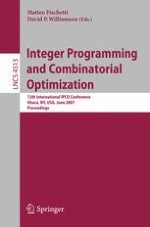2007 | Buch
Integer Programming and Combinatorial Optimization
12th International IPCO Conference, Ithaca, NY, USA, June 25-27, 2007. Proceedings
herausgegeben von: Matteo Fischetti, David P. Williamson
Verlag: Springer Berlin Heidelberg
Buchreihe : Lecture Notes in Computer Science
